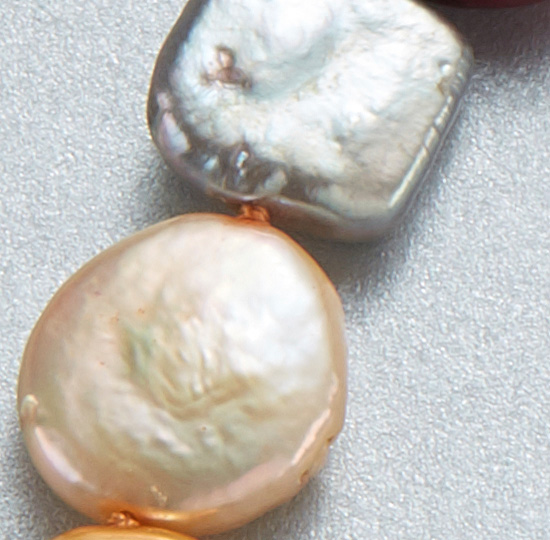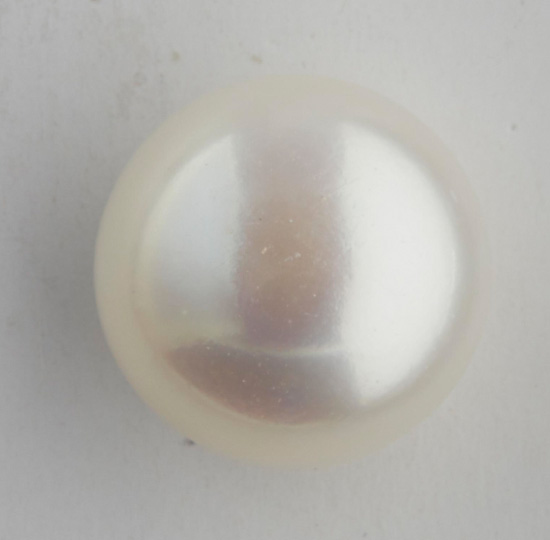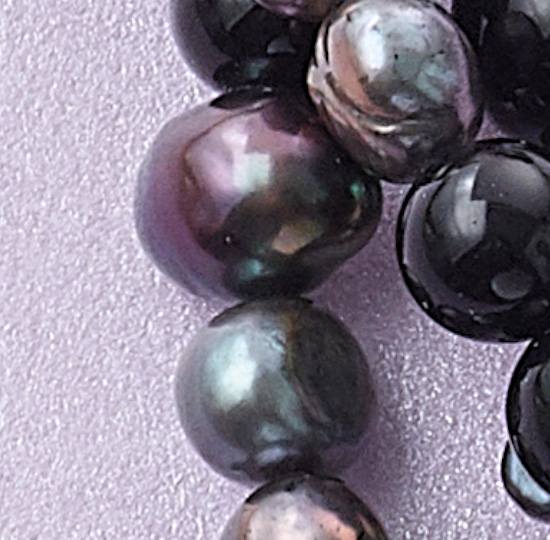Types of Pearls

Pearls are without doubt the best-loved gems of all time, both natural and cultured pearls. Pearls occur in a wide variety of colours, the most familiar of which are white, cream, grey, silver and pink, but the palette of pearl colours extends to every hue. The main colour, or body colour, is often highlighted by additional colours called overtones, which are typically pink, green, purple, or blue. Some pearls also show the iridescent phenomenon known as orient, which is a shimmer of rainbow colours just on or below a pearl’s surface.
Pearls also come in all sorts of shapes and sizes from perfectly round lustrous Akoya pearls to dark exotic Tahitian pearls. Each type of pearl has its own unique beauty and appeal. Their individual value depends on a range of factors from pearl type to size, shape, surface quality, colour and lustre. The highest value pearls will be rarer, rounder, larger, have a clean surface, a good colour and an excellent lustre.
Natural Pearls vs. Cultured Pearls
Natural Pearls
Natural pearls form in the bodies, or mantle tissue, of certain molluscs, usually around a microscopic irritant, and always form without human intervention. They are extremely rare and will usually have a unique shape based around the irritant that has led to their formation.
Cultured Pearls
The growth of cultured pearls requires human intervention and care. Today, most of the molluscs used in the culturing process are raised specifically for that purpose, although some wild molluscs are still collected and used.
To begin the process for Saltwater pearls, a skilled technician takes mantle tissue from a donor mollusc of the same species and inserts a shell bead along with a small piece of mantle tissue into a host mollusc’s gonad.
For Freshwater pearls several pieces of mantle tissue without beads are inserted into the host mollusc’s mantle. If a bead is used, the mantle tissue grows and forms a sac around it and secretes nacre inward and onto the bead to eventually form a cultured pearl. If no bead is used, nacre forms around the individual implanted mantle tissue pieces. Workers tend the molluscs until the cultured pearls are harvested
The time for pearls to be created depends on the type of mollusc or oyster shell that is being used, for Saltwater pearls growth time can vary between 1 – 4 years, for Freshwater pearls it is between 2 – 7 years.

Akoya Pearls

Keishi Pearls

Tahitian Pearls

Fireball Pearls

Coin Pearls

Button Pearls

Dark Freshwater Pearls
Pearl Types
There are four major types of cultured pearls:
Akoya Cultured Pearls
The Akoya pearl is the most familiar type of cultured pearl, Akoya pearls hail from the seas around Japan and China and are thought of as the perfect pearl because of their spherical shape and high lustre. The Akoya pearl was the first pearl to be cultivated in Japan in the early 20th Century. Produced by a small oyster called the Pinctada Fucata these highly desirable white pearls are the smallest saltwater pearls and are found in sizes ranging from 2mm to 10mm in size. The small size of the Akoya oyster means that it can only produce 1-2 pearls at a time and this limited production increases their value.
South Sea Cultured Pearls
Large round South Sea pearls are highly prized both for their size and for their satin-like lustre, they are produced by the white-lipped or golden-lipped variety of the Pinctada Maxima oyster, this type of pearl is commonly cultivated in deep water off the shores of Australia, Indonesia, and the Philippines. Found in shades of soft white through to honey gold, South Sea pearls can be found in the range of 8-20mm with the average size being 12mm. A high failure rate in the cultivation process and a long growth period means that these rare pearls continue to be among the most valuable pearls in the world.
Tahitian Cultured Pearls
Exotic Tahitian pearls are valued for their glorious array of colours and their mirror-like lustre. These dark and mysterious pearls consist of multitudes of overtones from peacock green and silver grey to lavenders and blues. Produced by the Pinctada Margaritifera oyster, which is found exclusively in Tahiti and several other French Polynesian islands, Tahitian pearls generally reach a size of 8-14mm but can grow up to 18mm and exceptionally as large as 21mm. Often less than 10% of the Tahitian pearl harvest results in round saleable pearls and this significantly increases their value.
Freshwater Cultured Pearls
Freshwater cultured pearls are the most commonly produced pearls in the world, and they are one of the most popular pearl types. Mainly cultivated in lakes and rivers in the China, Freshwater pearls are produced by a type of mussel shell called Hyriopsis, approximately 24-32 pearls can be created from each shell. Freshwater pearls come in a wide variety of shapes colours and sizes, and the pearls produced today are cleaner, rounder, and more lustrous than ever before. Freshwater pearl sizes typically range from 5mm to 10mm, though they can grow to 15mm or more, their natural colours range from white to lavender, cream, pink and peach. The fact that large numbers of Freshwater pearls can be produced in a wide variety of shapes, colours and sizes means that their price is more affordable, and this increases both their availability and their popularity.

